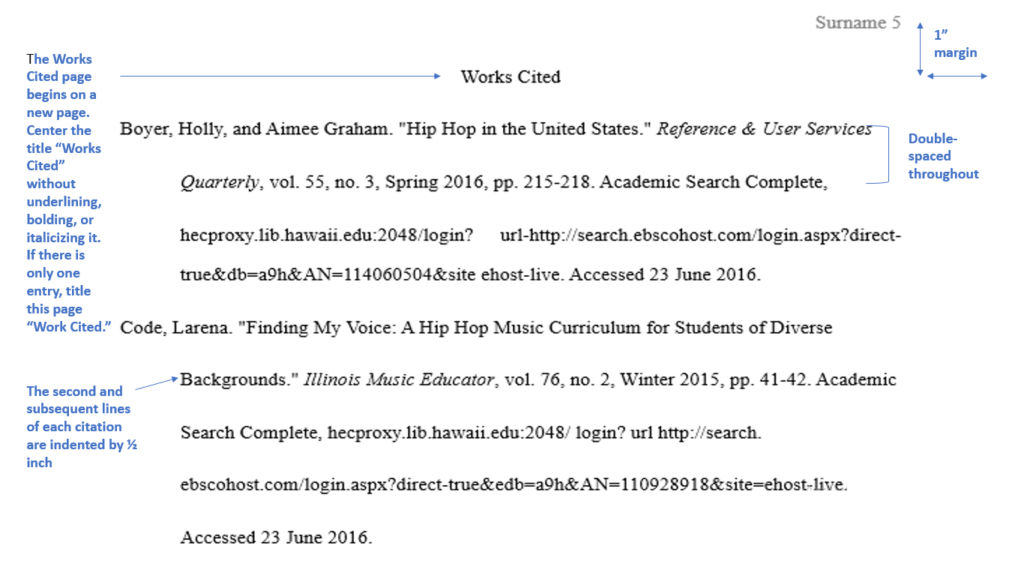Referencing Different Sources Using MLA Format
Referencing Different Sources Using MLA Format
In MLA format, different types of sources require specific formatting to provide accurate and consistent citations. Below we have provided the referencing formats for various common sources used in academic writing.
Books:
- Book by a single writer:
Works Cited: Brinkley, Alan. The Unfinished Nation: A Concise History of the American People. 7th ed., McGraw Hill, 2014, p. 525.
In-text citation: (Brinkley 525)
- Book by two writers:
Works Cited: Wilson, Charles, and Eric Schlosser. Chew on This: Everything You Don’t Want to Know about Fast Food. Houghton Mifflin, 2007.
In-text citation: (Wilson and Schlosser 67)
- Book by three or more writers:
Works Cited: James, Charles, et al. The Sociological History of People and Places. Magnolia Press, 2005.
In-text citation: (James et al. 157-165)
Websites:
Works Cited: Johnson, Sarah. “MLA Website Citation Guidelines.” Online Bibliography, 2022, www.onlinebibliography.com/mla-website-citation.
In-text citation: (Johnson)
Journal Article in a Database with a DOI:
Works Cited: Anderson, Emily. “The Impact of Climate Change on Biodiversity.” Environmental Studies Journal, vol. 15, no. 2, 2019, pp. 25-40. doi:10.1234/esj.15.2.28
In-text citation: (Anderson 28)
Newspapers:
Works Cited: Robinson, Mark. “New Discoveries in Space Exploration.” The Daily Times, 20 Nov. 2021, pp. A5-A6.
In-text citation: (Robinson A5)
Remember to consult the MLA Handbook or reputable online resources for specific instructions on formatting citations for less common sources, such as government documents, conference proceedings, or artwork.
Also read: How to successfully develop a thesis statement for a research paper.

Style and Language in MLA Format
Consistency in Writing Style:
Consistency in writing style is a fundamental aspect of MLA format. To maintain coherence and professionalism in your paper, it is crucial to adhere to a consistent writing style throughout. This includes consistent use of verb tense, sentence structure, and tone. Avoid shifting between formal and informal language, and strive for a consistent and scholarly tone in your writing.
Punctuation and Capitalization:
In MLA format, it is important to follow specific rules regarding punctuation marks and capitalization. Use standard punctuation marks such as commas, periods, and colons appropriately. Capitalize the first letter of each major word in titles and headings, while using lowercase for articles, prepositions, and conjunctions, unless they appear as the first or last word in a title.
Abbreviations and Acronyms:
When using MLA format, it is advisable to spell out terms fully upon their first mention, followed by their abbreviated form in parentheses. Afterward, the abbreviated form can be used consistently throughout the paper. However, ensure that the use of abbreviations does not compromise the clarity or readability of your text.
Using Italics and Quotation Marks:
Italics and quotation marks serve distinct purposes in MLA format when it comes to citing and emphasizing different types of sources. Italicize titles of longer works, such as books, journals, and films, while using quotation marks for shorter works like articles, poems, and song titles. Additionally, use quotation marks when directly citing someone’s words or when referring to specific terms or concepts. By correctly using italics and quotation marks, you provide visual cues that help readers navigate your citations and understand your intended emphasis.
Working with Non-English Sources:
In scholarly research, it is not uncommon to encounter non-English sources, such as foreign-language books, articles, or interviews. When referencing non-English sources, provide the original title in its original language, followed by an English translation in square brackets. This allows readers to understand the source’s title while maintaining the integrity of the original work. If quoting directly from a non-English source, provide an English translation within the text or as a footnote to ensure comprehension for readers who may not be familiar with the language.
Conclusion
Mastering the MLA format is a valuable skill that will not only help you achieve higher grades but also prepare you for future academic and professional endeavors. By following the guidelines outlined in this guidebook, you can ensure that your papers are well-structured, properly documented, and adhere to the standards set by the Modern Language Association. Correctly implemented in-text citations and a well-constructed Works Cited page showcase one’s intellectual integrity, while adherence to prescribed style and language conventions enhances the overall presentation of scholarly work.
